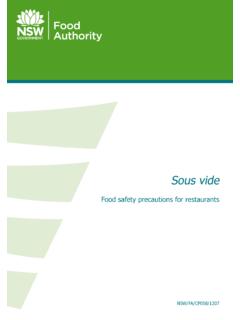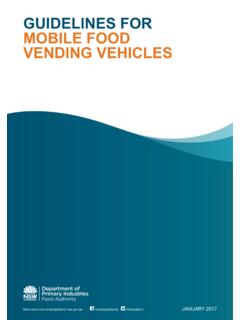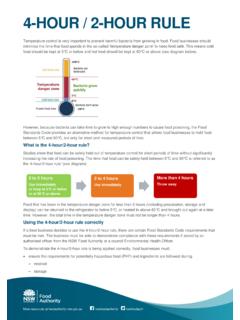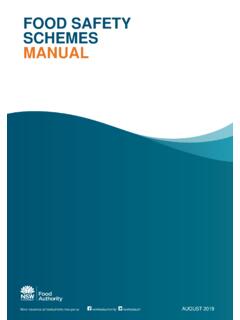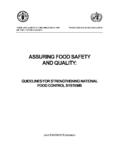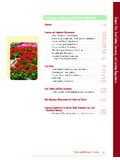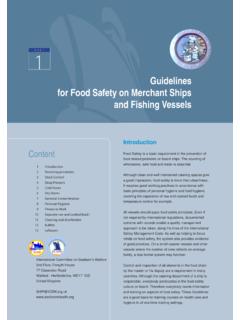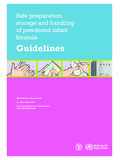Transcription of FOOD SAFETY GUIDELINES FOR THE …
1 food SAFETY . GUIDELINES FOR. THE preparation . OF RAW EGG. PRODUCTS. More resources at nswfoodauthority nswfoodauth SEPTEMBER 16. 2. Contents Introduction .. 3. Purpose and scope .. 6. Acknowledgements .. 6. Definitions .. 7. Receiving and storing eggs .. 9. Supplier and food information .. 9. Storage of whole eggs .. 9. Other 9. Processing eggs practical steps to control Salmonella .. 10. Equipment and utensils .. 10. Personal hygiene .. 10. Handling of eggs .. 10. preparation of acidified raw egg product .. 11. Egg pasteurisation using a sous vide method .. 11. Temperature control .. 12. Storage and display .. 12. Premises .. 13. Appendix 1: Acidification of raw egg products .. 14. Steps for measuring pH .. 14. Different pH measuring methods.
2 15. Raw egg product acidification check sheet .. 16. Appendix 2. Sous vide egg pasteurisation check sheet .. 17. Appendix 3: Temperature calibration and measurement .. 18. Calibration procedures .. 18. More resources at nswfoodauthority nswfoodauth 3. Introduction Salmonella is the most common type of bacteria associated with foodborne illness outbreaks in Australia. Mishandling of eggs and egg-based products are a significant contributor to foodborne illness in Australia, and in NSW. The pathogen Salmonella is known to be present on the surfaces of eggs and improper handling can lead to raw egg products becoming contaminated. There are a number of factors that contribute to the strong association between foodborne illness outbreaks caused by Salmonella and food that is sold which contains raw egg.
3 These include: Contamination of egg contents by Salmonella from the shell Failure to process (through acidification or heat) raw egg foods sufficiently to remove any Salmonella risk Failure to clean and sanitise equipment and food contact surfaces Temperature abuse ( storage above 5 C), and Keeping beyond recommended storage life (maximum 24 hours) at refrigerated temperature The practice of pooling eggs to produce a raw egg food significantly increases the likelihood of Salmonella contamination into a product which does not receive any further cooking or treatment to kill off harmful bacteria. Many large outbreaks of Salmonella food poisoning have occurred in NSW and nationally as a result of raw egg foods, particularly where business hygiene and temperature control issues were apparent.
4 The raw egg products that are most commonly implicated in Salmonella food poisoning include: Sauces and spreads made with raw egg mayonnaise, aioli, egg butter Desserts made without an effective cook step tiramisu, mousse, fried ice cream Drinks containing raw egg egg flip, raw egg high protein smoothies. The easiest solution to reducing the risk of your retail food business being implicated in a foodborne illness outbreak caused by Salmonella is to avoid selling food containing raw egg. The purpose of these GUIDELINES is to give food retail businesses that sell food containing raw egg specific SAFETY steps for its preparation and clear guidance and advice on how to meet food SAFETY regulations. These businesses are strongly advised to follow this guidance document.
5 All food businesses need to meet the requirements of the Australia New Zealand food Standards Code ( food Standards Code) to ensure they follow safe handling practices. In order to protect customers from the risk of foodborne illness, businesses need to comply with Standard , Division 3, Clause 7 (see page 4) to ensure that only safe and suitable food is processed. More resources at nswfoodauthority nswfoodauth 4. 7 food processing 1. A food business must . (a) take all practicable measures to process only safe and suitable food ; and (b) when processing food . i. take all necessary steps to prevent the likelihood of food being contaminated; and ii. where a process step is needed to reduce to safe levels any pathogens that may be present in the food use a process step that is reasonably known to achieve the microbiological SAFETY of the food .
6 2. A food business must, when processing potentially hazardous food that is not undergoing a pathogen control step, ensure that the time the food remains at temperatures that permit the growth of infectious or toxigenic microorganisms in the food is minimised This is particularly important for food businesses such as restaurants, caf s, bakeries and caterers that prepare and sell food containing raw egg. Given there is a known risk in the preparation of raw egg products, the NSW food Authority has developed these GUIDELINES to assist businesses to undertake practices that will ensure that they comply with requirements when making products known to cause salmonellosis. The following guidance is recommended: 1. Use safer alternatives to raw eggs in foods which are not cooked.
7 Alternatives include commercially produced dressings and sauces, or pasteurised egg products. 2. If using a raw egg product is the only option, then all of the following controls must be in place: a) Egg receival reputable suppliers, good delivery and storage, no cracked, dirty or unstamped eggs b) Storage correct storage and display of ingredients and product, including proper temperature control c) Processing correct handling such as good personal hygiene (including good hand washing practices and proper use of gloves if used), use of sanitised egg separator, proper temperature control d) Premises clean premises, fixtures, fittings and equipment, compliant hand wash facility, sanitised equipment (including egg separator) and food contact surfaces AND for foods containing raw egg, known to cause cases of salmonellosis steps e) and f) below e) The product is to be acidified to a pH of (or less) or effectively heat treated.
8 Foods containing raw eggs must be acidified to a pH of (or less) through the addition of acidic ingredients such as lemon or vinegar OR. Receive effective heat treatment such as sous vide to prevent contamination and growth of Salmonella. f) The treated raw egg product should be stored at or below 5 C for no longer than 24 hours and should be discarded at the end of the day. A fresh batch should be made daily. More resources at nswfoodauthority nswfoodauth 5. Note: Under the food Standards Code Division 3, Standard , to prevent disease causing bacteria to grow or produce toxins, the temperature of products must be either at or below 5 C during transport, storage and display. The food Standards Code allows for alternative compliance provided the businesses can demonstrate the product's SAFETY (Clause 25, Standard ).
9 The 4-hour / 2-hour rule' is used by food Standards Australia New Zealand (FSANZ) as an example of an alternative method for compliance (see page 12). If a business uses the 4-hour / 2-hour rule', then a documented system must be in place to demonstrate evidence that it is being used effectively. More resources at nswfoodauthority nswfoodauth 6. Purpose and scope This document aims to provide retail and food service businesses with information on the safe preparation of raw egg products. The document covers areas from receipt of eggs through to preparation of raw egg products. These areas can all potentially affect the SAFETY of the product. It also includes an example of a monitoring system for use when acidifying raw egg products. This document applies to the below foods that contain raw or lightly cooked egg known to cause cases of salmonellosis, including: sauces, dressings and creams deserts such as tiramisu, mousse and fried ice cream drinks such as shakes and smoothies Recommendations 2(e) and 2(f) (page 4) as laid out in this guideline do not apply to certain products that contain raw or lightly cooked egg and have little or no history of causing salmonellosis due to their traditional method of preparation , use or storage including: cooked egg sauces hollandaise and b arnaise sauce cooked breakfast style eggs such as scrambled or poached eggs and omelettes cakes and souffl s (baked).
10 Meringues (oven baked). icing (high sugar content). marshmallows (boiled during preparation ). frozen desserts such as ice cream or frozen mousse (frozen immediately after preparation ). traditional dishes that incorporate a raw egg added when serving such as tartare, congee, and soups This document does not cover all requirements of the food Standards Code, in particular requirements relating to premises and equipment. Businesses are urged to read the food Standards Code and ensure they meet the requirements of the Code as it relates to their business, including requirements for cleaning and sanitising. Acknowledgements This document has been developed with assistance from NSW local council environmental health officers. More resources at nswfoodauthority nswfoodauth 7.

